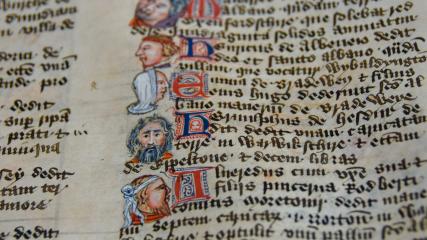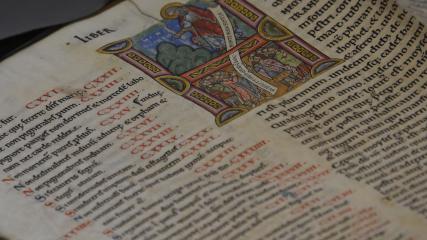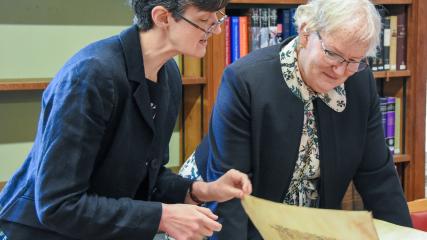The Parker Library passes its annual Audit - and the books will stay!
On Friday 3 February, College welcomed Professor Pippa Rogerson, Master of Gonville and Caius College, to carry out the annual Parker Audit.
Matthew Parker entrusted his library to Corpus in August 1574 and, under the terms of the indenture by which Matthew Parker donated his books to the Library, we are required to check the contents of the library every year. If a certain number of books have been lost, the whole collection is forfeit to Gonville and Caius College. If they should be similarly neglectful, the collection passes to Trinity Hall and, if necessary, back to Corpus. In this way, the three colleges were set to watch over each other – and each was provided with a copy of the Parker Register, the checklist of Parker’s books. Our copy is MS 575. Fortunately, all items in the Register have once again been accounted for.
The Master, Professor Christopher Kelly, and the Donnelley Fellow Librarian and Director of the Parker Library, Dr Philippa Hoskin, were there to greet Pippa and show her some of the Parker manuscripts. She specifically asked to see MS 140: The Bath Old English Gospels, which contains the four gospels in Old English, specifically in West-Saxon Old English, written in the second half of the eleventh century at Bath Abbey in Somerset. Philippa also brought out from the vault two of the Library's great treasures: MS 007: Chronicle and Register of Benefactors of the Monastery of St Albans (c1400-1499) and MS 003: The Dover Bible, Volume I.
Finally, they looked at a copy of the Caius statues from c1572, that John Caius (the second founder of Gonville and Caius College) was in the process of revising. He sent the copy to his good friend Archbishop Matthew Parker, potentially for comments and feedback. There are three large seals attached to the booklet of statutes: that of Matthew Parker, of Caius himself and Caius College.
The Chronicle and Register of the Monastery of St Albans (left) contains numerous illustrations to represent the benefactors, a few as full figures but mostly as busts or heads. The muted blue in this illustration from the Dover Bible (right) may be due to the possibility that a layer of valuable, deeper blue lapis lazuli pigment was scraped off by a scribe for use elsewhere.



